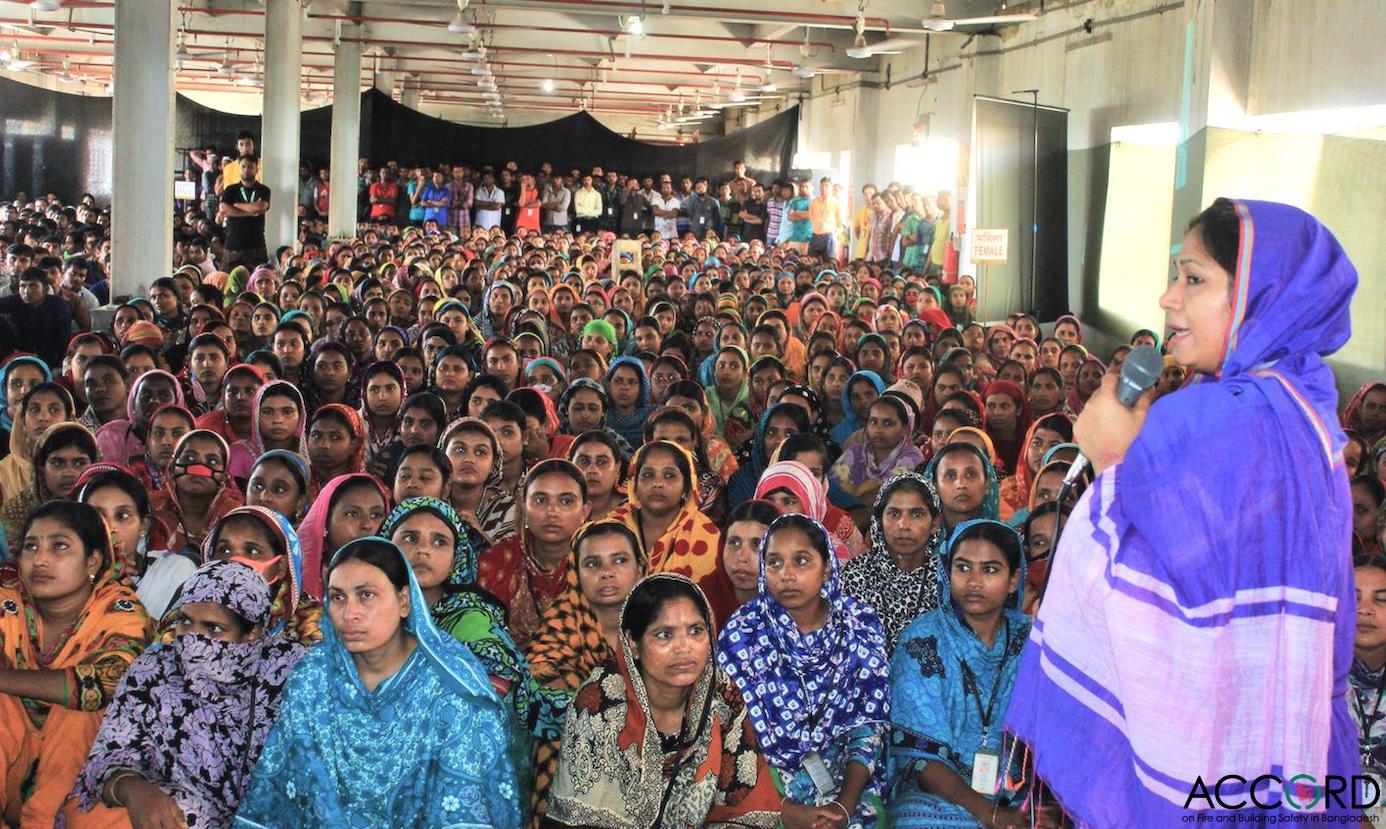Bangladesh Accord: An urgent call-to-action to #ProtectProgress
In this guest blog post by Anvita Srivastava, revisit Rana Plaza to discover why the call for an extension to the Bangladesh Accord on Fire and Building Safety is so urgent.
No one should die for fashion, and that’s why this legally binding agreement between apparel brands and global trade unions help ensure that disasters like Rana Plaza never happen again. Unfortunately, this game-changing agreement expires on 31st May 2021. If the Accord is not renewed, the safety of over 2 million workers in 1,600 garment factories will be left in the hands of voluntary, non-enforceable Corporate Social Responsibility (CSR) initiatives, which have been unable to prevent mass casualties.
Brands must stop dragging their feet and sign on to the renewed Bangladesh Accord now, and help extend the internationally binding agreement to other countries where garment workers still face unsafe working conditions. We shouldn’t have to wait for another Rana Plaza for change to happen.

Before the Accord: Rana Plaza
On 23rd April 2013, a TV channel recorded footage that showed noticeable deep cracks in the eight-storey Rana Plaza building. The top five floors of the building were occupied by five garment factories. The shops and banks on the lower floor were closed and people immediately evacuated. By the end of the day, the building was deemed safe by the building owners and workers were asked to return the next day.
At around 9 am on 24th April, with over 3,000 factory workers inside, the Rana Plaza building collapsed completely burying thousands of workers under it. The local people nearby described the collapse as a massive earthquake. Immediately the onlookers and neighbours rushed towards the site, to see body parts buried under a twisted mass of metals, concrete, and machinery and hear the cries for help.
As the enormity of the tragedy quickly became apparent, locals and rescuers tried to evacuate as many people as possible. Haunting photographs of family members desperately looking for their loved ones through the debris circulated online. Relatives were seen with handkerchiefs trying to block out the rancid smell as they tried to identify their family members through rows of dead bodies. In the days following the incident, rescuers were still trying to dig with drills, shovels and bare hands to retrieve the bodies buried under the wreckage. The final evacuation ended almost after a month in May, with the incident drawing global attention and public anger.
The factory workers had pleaded to not be sent inside that morning. The supervisors chose to ignore the warning signs and threatened them with a month’s salary cut if they did not comply. Later the world witnessed the aftermath of a completely avoidable disaster in disbelief.
Why did the workers still enter the factory?
In the days and weeks leading up to the collapse, workers were anxious about cracks in the building and had even previously been evacuated the day before due to safety concerns. The supervisors and managers cajoled them to work that day. But why?
The answer lies in the massive income disparity between the workers and the brands they produce for. To give you an idea at the time of the incident workers earned between 35 USD and 60 USD per month for a pair of jeans that cost less than 5 USD to produce and would sell for more than 80 USD globally. Their vulnerability and struggle for survival make them the disposable assets of the supply chain. In addition to that, the majority of the garment workers are young women, often victims of gender-based violence. Many of them financially support their families and fear of losing jobs is greater than the risk to their lives.
“Our tasks kept piling up. The bosses said they wouldn’t let us leave until we had finished the task, and said we wouldn’t get the day’s salary plus the two hours of overtime if we left without finishing the order. We get a pretty small salary. We can’t risk losing even a tiny part of it.” – Roksana
“Darkness engulfed the entire place with thick clouds of debris. I heard screams around me. My heart started pounding…I lay down near a pillar, thinking that perhaps I was going to die. We were being roasted inside.” – Mahmudul Hasan (source)
As distressing as these testimonies are, the incident itself was depressingly predictable. Bangladesh is the second-largest exporter of garments in the world and employs roughly 4.4 million people, mostly women, contributing more than 11% to the country’s GDP. Unsurprisingly, the Rana Plaza was far from the first or even the last incident of its kind in the notoriously unsafe Bangladesh garment industry. It is, however, considered the worst disaster in the garment industry as the factories were producing clothes for many major brands, who after several audits had failed to detect the safety violations that would ultimately lead to the tragedy.
The investigation revealed that the factory was built without proper permission on unstable land, over a filled-in pond. The owner had also built the last three stories illegally using sub-par construction materials thus compromising its structural integrity. The building was inefficiently inspected and poorly managed. The factory supervisors main concern was to meet the order deadlines and workers safety was not their priority. The brands insisted they had conducted the audits as per regulatory requirements. Then how is it possible that none of the audits could detect the violations? Some of the reasons provided were that the audit scope only covered the basic supplier criteria and did not include assessing the building’s structural integrity.
The aftermath of Rana Plaza
Public outcry over the collapse and regulatory issues forced the largely Western apparel companies to take action and ensure the safety of workers in their supply chain. Over 200 brands and retailers joined forces to collaboratively develop two historic parallel agreements called the Accord on Fire and Building Safety in Bangladesh and the Alliance for Bangladesh Worker Safety. The Accord is the first modern legally binding agreement between global brands and retailers and trade unions that represent garment workers. It is governed by a Steering Committee with equal representation of apparel companies and trade unions with a neutral chair provided by the International Labor Organistion (ILO).
It is a crucial breakthrough for workers’ rights as it holds the brands, retailers and factories accountable through arbitrations on failure to fulfil the obligations. It aims to ensure building safety by establishing a legitimate system to conduct factory inspections and take corrective actions. It has also enhanced supply chain transparency by listing all the signatories, supplier factories in the public domain and publishing inspection outcomes, measures and factory performance over time. Lastly, it has been instrumental in giving a voice to the workers by including worker unions in their governance structure and actively involving them in the decision-making process.

Impact of the Accord
Since its inception, the Bangladesh Accord has brought about a much-needed change in the Bangladesh garment industry and led to tremendous progress in factory working conditions. The numbers speak for themselves. More than 145,000 safety violations have been detected at covered factories under the Accord since 2013, of which 93% of safety issues identified during initial inspections are now remedied. Over 1,300 joint labour-management factory level Safety Committees have been set up to monitor safety measurements regularly. The Accord’s grievance mechanism has also proved effective in resolving over 700 safety complaints from factory workers and their representatives.
Unfortunately, the Accord expires in May 2021. Frequent and almost regular reports of fire and safety accidents in Bangladesh garments factories have made it more than evident that the Accord’s work cannot be handed over to the ill-equipped national agencies. The last reported incident in Bangladesh took place on 8th March 2021 at a textile chemical factory, taking the life of one and injuring 20 others.
With the Accord soon coming to an end, the workers will be left at the mercy of voluntary programmes without its legal enforcement. Its effectiveness can largely be attributed to the inclusion of unions as signatories who can keep the member brands and retailers accountable. Covid pandemic has exacerbated the workers’ financial woes and there is still an immense amount of work to be done. But the Accord’s expiration runs the risk of it turning into another industry-led voluntary tool.
According to Clean Clothes Campaign, the Bangladesh Accord has brought great progress to the safety situation for over 2 million garment workers in Bangladesh, but this progress must be protected:
“The Bangladesh Accord is so successful because it is a binding agreement that has real punishments for brands, retailers, and factories that do not take enough action. Unions take up half of the seats in the Accord’s governance structures and can hold brands accountable. An international binding agreement will have to be signed to keep the Accord’s most effective elements in place, and can also be used to ensure that eventually other countries will be covered by a similar programme.”
As consumers, we can do our part by sharing support for the Accord’s extension and calling upon brands to take action to #ProtectProgress.
We can do this by first informing ourselves of the challenges faced by garment workers and the mechanisms in place to ensure their safety. Greater awareness among consumers can make our voices loud enough to be heard by powerful brands and retailers. After all every time we wear a clothing item with the tag “Made in Bangladesh”, we owe its very existence to an unknown and unrecognised factory worker toiling for the rich brands. The least we can do is share our privilege and platform to demand a humane, safe and dignified workplace for those whose cries for justice have been deliberately silenced and unheard for too long.
For more information about the Bangladesh Accord, watch this video from Clean Clothes Campaign:
Sources:
https://www.wsj.com/articles/SB10001424127887323789704578444280661545310
https://www.reutersevents.com/sustainability/supply-chains/rana-plaza-rebuilding-more-factory
https://www.hrw.org/news/2017/05/11/bangladesh-accord-new-phase-should-protect-unions
https://cleanclothes.org/campaigns/protect-progress
https://www.opendemocracy.net/en/opensecurity/reason-and-responsibility-rana-plaza-collapse/
https://www.emerald.com/insight/content/doi/10.1108/AAAJ-07-2015-2141/full/html
https://papers.ssrn.com/sol3/papers.cfm?abstract_id=3265826
https://www.workersrights.org/our-work/bangladesh-accord/








